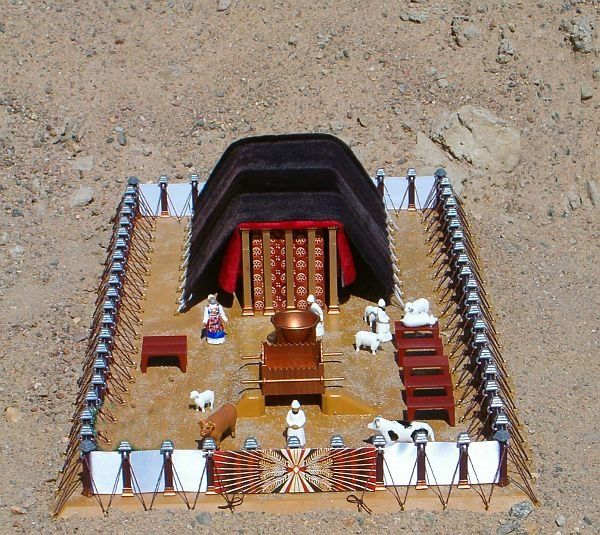Major Themes of the Tabernacle/Mishkan
- Going from the profane/polluted to the kadosh/set-apart, from darkness to light, disobedience to obedience.
- Progressive separation and refinement of the individual leading to purity and perfection.
- Growing in progressive intimacy and fellowship with the Father.
- The steps of the biblical wedding ceremony; the marriage of YHVH to his people.
- The seven steps of spiritual growth and reconciliation to the Father as epitomized by the seven annual appointed times or festivals (moedim).
The tabernacle/mishkan was constructed circa 1450 b.c. at the foot of Mount Sinai. It took about a year to build.
Hebrew Names for the Tabernacle
- Mishkan is Strong’s H4908 meaning “tabernacle, dwelling or habitation.” mishkan is from the root word shakan/ifÑ (Strong’s H7391) meaning “to dwell, abide, settle down, reside, tabernacle.” The word shechinah derives from shakan and refers to the manifest light or presence of YHVH among his people (Exod 25:8–9).
- Ohel (as in tent of the congregation/meeting) is Strong’s H166 meaning “a nomad’s tent, dwelling, home, habitation” (Exod 29:42).
- Miqdash is Strong’s H4720 meaning “sacred place, sanctuary, holy place” and is from the primitive root qadash/Ñse (Strong’s H6942) meaning “to consecrate, sanctify, prepare, dedicate, be hallowed or set apart, be separate or holy” (Exod 25:8).
- Kodesh or sanctuary because it was set-apart for a set-apart (kadosh) Elohim (Exod 30:13).
- Ohel haeduth or the tabernacle/tent of the testimony or witness since it contained the ark of the covenant housing the Torah-law given to Moses, which was an abiding witness of Israel’s covenant with YHVH (Num 9:15).
- Mishkan haeduth or tabernacle of the testimony (Num 10:11).
Examples of YHVH Tabernacling With His People
The children of Israel have just left Egypt and are now trekking through the wilderness. Within a couple of months, he gives them their first assignment. In Exodus 25, YHVH tells them to build a tabernacle. Why? He says to Moses, “And let them make me a sanctuary that I may dwell among them” (Exod 25:8). From the beginning, in the Garden of Eden, Elohim has wanted to “hang out” with man. Elohim’s desire to dwell or tabernacle with man is a theme that runs from Genesis to Revelation. We see this idea repeated in the Testimony of Yeshua (the New Testament).
John 1:14, “And the Word was made flesh and dwelt among us, (and we beheld his glory, the glory as of the only begotten of the Father,) full of grace and truth.” The word dwelt (skenoo, Strong’s G4637) means “tent or tabernacle.”
Luke 2:7, The baby Yeshua was laid in a “manger.” This was probably a sukkah or tabernacle.
Revelation 21:1–3, “Now I saw a new heaven and a new earth, for the first heaven and the first earth had passed away. Also there was no more sea. Then I, John, saw the holy city, New Jerusalem, coming down out of heaven from Elohim, prepared as a bride adorned for her husband. And I heard a loud voice from heaven saying, ‘Behold, the tabernacle of Elohim is with men, and He will tabernacle with them, and they shall be His people. Elohim Himself will be with them and be their Elohim.’” The word tabernacle in verse three is skenoo in the Greek, the same word used in John 1:14.
Examples of YHVH’s People Tabernacling With Him
The talithe/talit or prayer shawl worn by Jewish men is an examples of YHVH’s people tabernacling with him. The word tal-ithe means “little tent.” Each Hebrew man has his own little tabernacle, tent or prayer closet to pull over his head whenever he wants to tabernacle or commune with his Elohim. When a talit is spread out with one’s arms it resembles a bird with wings. This represents YHVH’s “wings” forming a protective shield or brooding over his people. Such a place becomes a place of refuge (Ps 91:1,4). The Spirit of Elohim brooded over the waters of the earth at creation (Gen 1:2). Yeshua spoke of his desire for Jerusalem as a mother hen spreads out its wings and gathers together its young (Matt 23:37). In ancient Mideast culture, a man would cast his outer garment over his wife-to-be as an act of claiming her for marriage. In Ezekiel 16:8, YHVH spread is “wings” (Heb. kanaph meaning “edge, extremity, wings, bird’s feathered wings,” Strong’s H3671) over his bride, Israel, to cover her nakedness. The Jewish wedding canopy or chuppah represents this.
Constructing the Tabernacle—All Israel Was Involved
All Israel contributed to the building of the tabernacle (Exod 25:1–7), yet YHVH chose two Israelite artisans, Bezalel and Aholiab (Exod 31:1–6), filled them with the Spirit of Elohim “in wisdom, understanding, knowledge an in all manner of workmanship …” This teaches us that the work of YHVH is a joint effort of the entire Body of YHVH-Yeshua, but that YHVH will endow certain individuals with unique gifts of the Spirit in order to accomplish his specific plans and purposes (Eph 2:22; 4:11; Rom 12:4–8; 1 Cor 12 and 14).
The Israelite Encampment Around the Tabernacle
The Israelites camped around the tabernacle (Num 2:1–34). On the east side were Judah, Issachar and Zebulun; on the South side were Reuben, Simeon and Gad; on the west side were Ephraim, Manasseh and Benjamin; and on the north side were Dan, Asher and Naphtali. According to the numbers of the fighting men given in Numbers 2, we see that the encampment of Israelites around the tabernacle formed a perfect paleo-Hebrew letter tav, which looks like a cross. The Levites camped around the tabernacle forming a protective perimeter between the Israelites and the tabernacle itself (Num 1:53).


